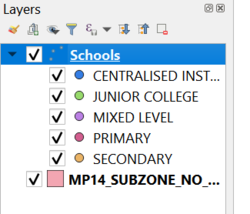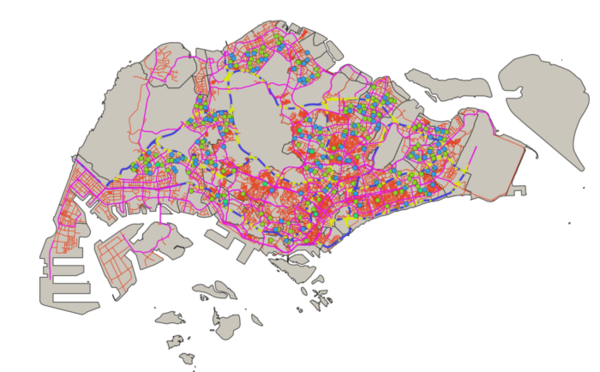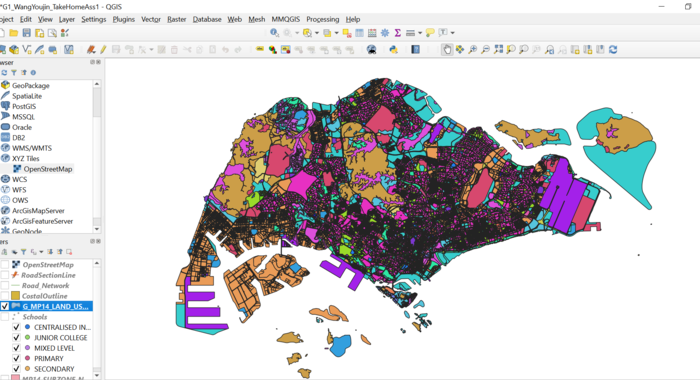|
1. `SumAgedPopulation2010_PA` layer joined with `sum_aged_pop_2010_pa` by matching attribute `PLN_AREA_N` and `Zone_ID_PA`.
a. Symbology (Natural Jenks):
[[File:|center|400px]]
FIGURE XVI
CATEGORISATION OF PLANNING AREA SUM AGED POPULATION DATA
2. `SumAgedPopulation2018_PA` layer joined with `sum_aged_pop_2018_pa` by matching attribute `PLN_AREA_N` and `Zone_ID_PA`.
a. Symbology (Natural Jenks):
[[File:|center|400px]]
FIGURE XVII
CATEGORISATION OF PLANNING AREA SUM AGED POPULATION DATA
3. `SumAgedPopulation2010_SZ` layer joined with `sum_aged_pop_2010_sz` by matching attribute `SUBZONE_N` and `Zone_ID_SZ`.
a. Symbology (Natural Jenks):
[[File:|center|400px]]
FIGURE XVIII
CATEGORISATION OF SUBZONE SUM AGED POPULATION DATA
4. `SumAgedPopulation2018_SZ`layer joined with `sum_aged_pop_2018_sz` by matching attribute `SUBZONE_N` and `Zone_ID_SZ`.
a. Symbology (Natural Jenks):
[[File:|center|400px]]
FIGURE XIX
CATEGORISATION OF SUBZONE SUM AGED POPULATION DATA
5. `ProportionAgedPopulation2010_SZ` layer joined with `propotion_aged_pop_2010` by matching attribute `SUBZONE_N` and `Zone_ID_SZ`.
a. Symbology (Natural Jenks):
[[File:|center|400px]]
FIGURE XX
CATEGORISATION OF SUBZONE PROPORTION AGED POP DATA
6. `ProportionAgedPopulation2018_SZ` layer joined with `propotion_aged_pop_2018` by matching attribute `SUBZONE_N` and `Zone_ID_SZ`.
a. Symbology (Natural Jenks):
[[File:|center|400px]]
FIGURE XXI
CATEGORISATION OF SUBZONE PROPORTION AGED POP DATA
7. `Percentage_Change_SZ` layer joined with `2010_2018_percentage_change` by matching attribute `SUBZONE_N` and `Zone_ID_SZ`.
a. Symbology: Below is the configuration used for percentage change of aged population. The legend classification intervals were split into 2 ways, negative changes which represents a decrease change were categorised using an equal distribution from the minimum decrease value of -100% to 0. Next, Natural Breaks (Jenks) were used to classify the 5 next categories for the positive values to indicate. Due to its high variance value, the Jenks classification represents best for this case. Additionally, 2 distinct colours (red and blue) were used to appropriately display the nature of percentage change of the aged population from 2010 to 2018.
[[File:|center|500px]]
FIGURE XXII
CATEGORISATION OF SUBZONE PERCENTAGE CHANGE DATA
[[File:|center|500px]]
FIGURE XXIII
3 BASE COLOR PICK FOR SUBZONE PERCENTAGE CHANGE DATA
[[File:|center|400px]]
FIGURE XXIV
DATA LABELLING
For
[[File:|center|200px]]
FIGURE XXV
CATEGORISATION OF SUBZONE PERCENTAGE CHANGE DATA
Enabling each layer’s label can be done via `Layer Properties`.
| 

